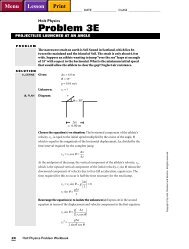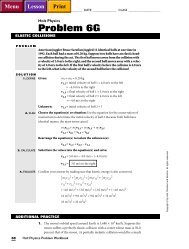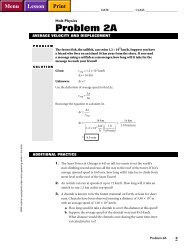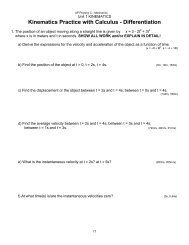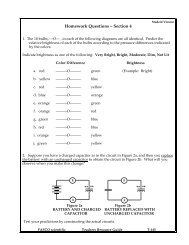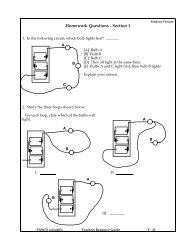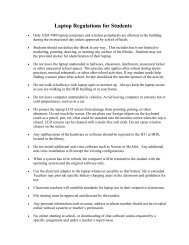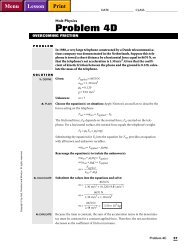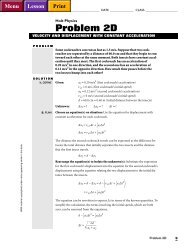KSHSAA Heat Safety & Hydration Information - Hays High School
KSHSAA Heat Safety & Hydration Information - Hays High School
KSHSAA Heat Safety & Hydration Information - Hays High School
You also want an ePaper? Increase the reach of your titles
YUMPU automatically turns print PDFs into web optimized ePapers that Google loves.
HOW CAN I PREVENT HEAT ILLNESS IN MY ATHLETES?Proper HYDRATION and ACCLIMATIZATION practices stand out as the two primary prevention methods fordecreasing the risk of heat illness. The following are some basic principles to follow:HYDRATION RECOMMENDATIONS & CONSIDERATIONSAppropriate hydration before, during and after exercise is important for maintaining peak athletic performance. Fluidlosses of as little as 2% of body weight (less than 4 pounds in a 200-pound athlete) can impair performance by increasingfatigue. This is important because it’s common for some athletes to lose between 5-8 pounds of sweat during a game orintense practice. So it’s easy for athletes to become dehydrated if they don’t drink enough to replace what is lost in sweat.Recognize and respond to early warning signs of dehydration.DRINK EARLY and DRINK OFTEN during activity. Do not let athletes rely on thirst. Schedule frequent fluidbreaks for re-hydrating. If athletes wait until they are thirsty it may be too late.Athletes should be weighed before and after warm weather practices. They need to drink appropriate amounts of fluidfor the amount of weight lost. Also, use a urine color chart (see back page) to determine hydration levels beforeactivity.Encourage GOOD hydration choices: water, sport drinks with low sodium and carbohydrates,AVOID: soda, fruit juices, carbonated beverages, and caffeine.Encourage drinking fluids, not pouring them. Dumping fluid over the head won't help restore body fluids or lowerbody temperature.Provide easily accessible fluids.Before ExerciseDuring ExerciseDrink 16 oz of fluid before activity/exercise (2 hours)Drink another 7-10 oz of fluid 10-15 minutes before exerciseDrink 4 -16 oz of fluid every 15-20 minutesAfter ExerciseDrink 24 oz of fluid for every (one) pound lost during exercise within 6 hours of stopping theactivity. This is to achieve normal fluid state and not begin the next practice dehydrated.Fluid counter24 oz of fluid = 1 ½ of water bottle16 oz of fluid = 1 full water bottle7 oz of fluid = ½ full water bottle or 10 BIG gulps of water4 ox of fluid – ¼ full water bottle or 5 BIG gulps of waterACCLIMATIZATION RECOMMENDATIONS & CONSIDERATIONSThe goal of the acclimatization period is to enhance the body’s ability to exercise safely and effectively in warm tohot conditions.The heat acclimatization period is defined as the initial 14 consecutive days of preseason practice.Slowly increase practice intensity and duration over this time. Schedule practice in the morning or evening when theweather is coolest.Each individual practice should last no more than 3 hours. Any time spent warming-up, stretching, conditioning,weight lifting, and performing cool down activities are all considered part of the 3 hours.A walk-through does not need to be included as part of the 3 hours, provided no conditioning or weight lifting takesplace. A walk-through should not last longer than 1 hour. A 3 hour recovery period should exist between a practiceand a walk-through.Double practices in a single day should not begin until the 6 th day of the acclimatization period.
HEAT ILLNESS SIGNS/SYMPTOMS & MANAGEMENT<strong>Heat</strong> illness is a general term used to describe many different conditions that can result from physical activity in anenvironment of extreme heat and/or humidity. These conditions are a result of the body becoming dehydrated and/orlosing the ability to cool itself. The signs and symptoms of heat illness do NOT necessarily run on a continuum.This means that a person could suffer from heat stroke without showing less severe heat illness conditions such asheat cramps. Please keep this in mind when evaluating the signs and symptoms of your athletes.<strong>Heat</strong> Cramps – Signs and Symptoms Cramping that occurs in active muscles Cramping in the abdominals and legs mostcommon<strong>Heat</strong> Syncope – Signs and Symptoms Weakness Fatigue Fainting<strong>Heat</strong> Exhaustion – Signs and Symptoms Rapid weight loss (water) Muscle cramps Nausea /vomiting Headache Reduced sweating (clammy skin) Dizziness / Fainting Fatigue or weakness<strong>Heat</strong> Stroke – Signs and Symptoms No sweating Hot, dry skin Nausea /vomiting Seizures Disorientation Loss of consciousness<strong>Heat</strong> Cramps – Management Rest in a cool place Gentle stretching and massage muscle Drink WATER<strong>Heat</strong> Syncope -Management: Lay athlete down in cool place Drink WATER Athlete is NOT allowed back to activity Should be seen by a physician<strong>Heat</strong> Exhaustion -Management: Treat heat exhaustion as an emergency. Call for emergency medical assistance & movepatient to shade/cool building. Remove clothing and immerse torso in ice/coldwater. Place ice bags over pulse points (armpits, groinand neck) If conscious give WATER slowly<strong>Heat</strong> Stroke -Management: <strong>Heat</strong> stroke is life-threatening! Call for emergency medical assistance & movepatient to shade/cool building. Remove clothing and immerse torso in ice/coldwater. Place ice bags over pulse points (armpits, groinand neck) Do NOT give WATER (fluids)!REFERENCESBinkley HM, Beckett J, Casa DJ, et al. National Athletic Trainers’ Association position statement: Exertional heat illnesses. Journal of Athletic Training. 2002; 37(3):329-343.Casa DJ, Armstrong LE, Hillman SK, et al. National Athletic Trainers’ Association position statement: Fluid replacement for athletes. Journal of Athletic Training.2000; 35(2): 212-224.Casa DJ, Csillan D. Preseason heat-acclimatization guidelines for secondary school athletics. Journal of Athletic Training. 2009; 44(3): 332-333.National Federation of State <strong>High</strong> <strong>School</strong> Assocations. Fluid replacement for athletes. Sports Medicine Handbook, 3 rd Edition. 2008; 43-46.The information in this document is provided by the Kansas State <strong>High</strong> <strong>School</strong> Activities Associationwith content contribution from the Kansas Athletic Trainer’s Society. The information is meant toprovide general information and guidelines for schools to consider when creating or updating theirschool’s heat/hydration policy.
How Hydrated Are You?This urine color chart is a simple tool you can use to assess if you are drinking enoughfluids throughout day to stay hydrated.HYDRATEDDEHYDRATEDYou need to drink more fluidbefore returning to any physicalactivity!Be Aware! If you are taking single vitamin supplements some of the vitamins canchange the color of your urine for a few hours, making it bright yellow or discolored.




